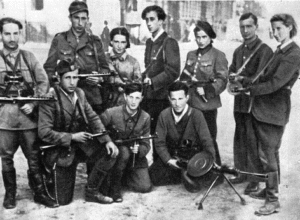 In an adapted excerpt from her forthcoming book, The Light of Days: The Untold Story of Women Resistance Fighters in Hitler’s Ghettos, Judy Batalion writes about her discovery of the stories of dozens of women who fought in the Jewish resistance against the Nazis in Europe during World War II. Batalion shares that even as the granddaughter of Holocaust survivors who has a doctorate in women’s studies, she had never heard these stories or the names of these women fighters. While living in London in 2007 she visited the British Library to find out more about one Jewish woman she had read about as a child whose name and brave exploits she remembered. While hunting for material on this one woman, she stumbled upon a 180-page handwritten book entitled, Women in the Ghettos, written in Yiddish. This book detailed, many stories of “young Jewish women who defied the Nazis, many of whom had the chance to leave Nazi-occupied Poland but didn’t; some even voluntarily returned.” Batalion notes that some resistance narratives like these were published after the war but were sidelined or ignored and then forgotten. Batalion spent dozens of years in research archives and in living rooms across Poland, Israel, and North America reconstructing as many of the narratives as she could find of the Polish Jewish “ghetto girls” who
In an adapted excerpt from her forthcoming book, The Light of Days: The Untold Story of Women Resistance Fighters in Hitler’s Ghettos, Judy Batalion writes about her discovery of the stories of dozens of women who fought in the Jewish resistance against the Nazis in Europe during World War II. Batalion shares that even as the granddaughter of Holocaust survivors who has a doctorate in women’s studies, she had never heard these stories or the names of these women fighters. While living in London in 2007 she visited the British Library to find out more about one Jewish woman she had read about as a child whose name and brave exploits she remembered. While hunting for material on this one woman, she stumbled upon a 180-page handwritten book entitled, Women in the Ghettos, written in Yiddish. This book detailed, many stories of “young Jewish women who defied the Nazis, many of whom had the chance to leave Nazi-occupied Poland but didn’t; some even voluntarily returned.” Batalion notes that some resistance narratives like these were published after the war but were sidelined or ignored and then forgotten. Batalion spent dozens of years in research archives and in living rooms across Poland, Israel, and North America reconstructing as many of the narratives as she could find of the Polish Jewish “ghetto girls” who
- Paid off Gestapo guards
- Hid revolvers in teddy bears
- Flirted with Nazis and then killed them
- Distributed underground bulletins and forged papers to ghetto inhabitants
- Flung Molotov cocktails
- Bombed train lines
- Organized soup kitchens for starving ghetto inhabitants
What do we know about the Jewish resistance? Batalion writes that “more than 90 European ghettos had armed Jewish resistance units. Approximately 30,000 European Jews joined the partisans. Rescue networks supported about 12,000 Jews in hiding in Warsaw alone. . . . Women, aged 16 to 25, were at the helm of many of these efforts.” So-called courier girls connected the locked ghettos where Jews were imprisoned by slipping in and out of ghettos with information, hope, bulletins, false identification papers, and food. They smuggled pistols, bullets, and grenades in food packages and clothing. Because they were not circumcised like their brothers and were often educated in Polish public schools while their brothers attended Jewish schools and yeshivas, the young women were better positioned than their brothers to pass as Polish and work as spies.
It is important to say the names of some of these women so they are not forgotten. Here are some of the names and snippets of the stories of women Batalion has recovered:
- Renia Kukielka was chosen for undercover missions as a courier girl after she escaped the ghetto where her family was imprisoned. She moved grenades, false passports, and cash strapped to her body and transported Jews from ghettos to hiding spots.
- Bela Hazan got a job working as a translator and receptionist for the Gestapo and stole documents to deliver to Jewish forgers.
- Vladka Meed smuggled dynamite into the Warsaw ghetto by passing bits of gunpowder through a hole in the wall of a basement on the ghetto border.
- Hela Schupper dressed up as an affluent Polish woman and brought five guns and clips of cartridges to a militia in Krakow.
- Ruzka Korczak in Vilna found a Finnish pamphlet about how to make bombs that became the underground’s recipe book.
- Vitka Kempner blew up a German supply train after slipping out of the Ghetto with explosives under her coat.
- Zelda Treger completed seventeen trips transporting hundreds of Jews out of ghettos and slave labor camps.
- Haviva Reik and Hannah Senesh joined the British Army as paratroopers, helping thousands of Slovak Jews and rescuing Allied servicemen.
The legacies of these strong women can inspire us—but only if we know their names and their stories.
Photo courtesy of Cedric Labrousse